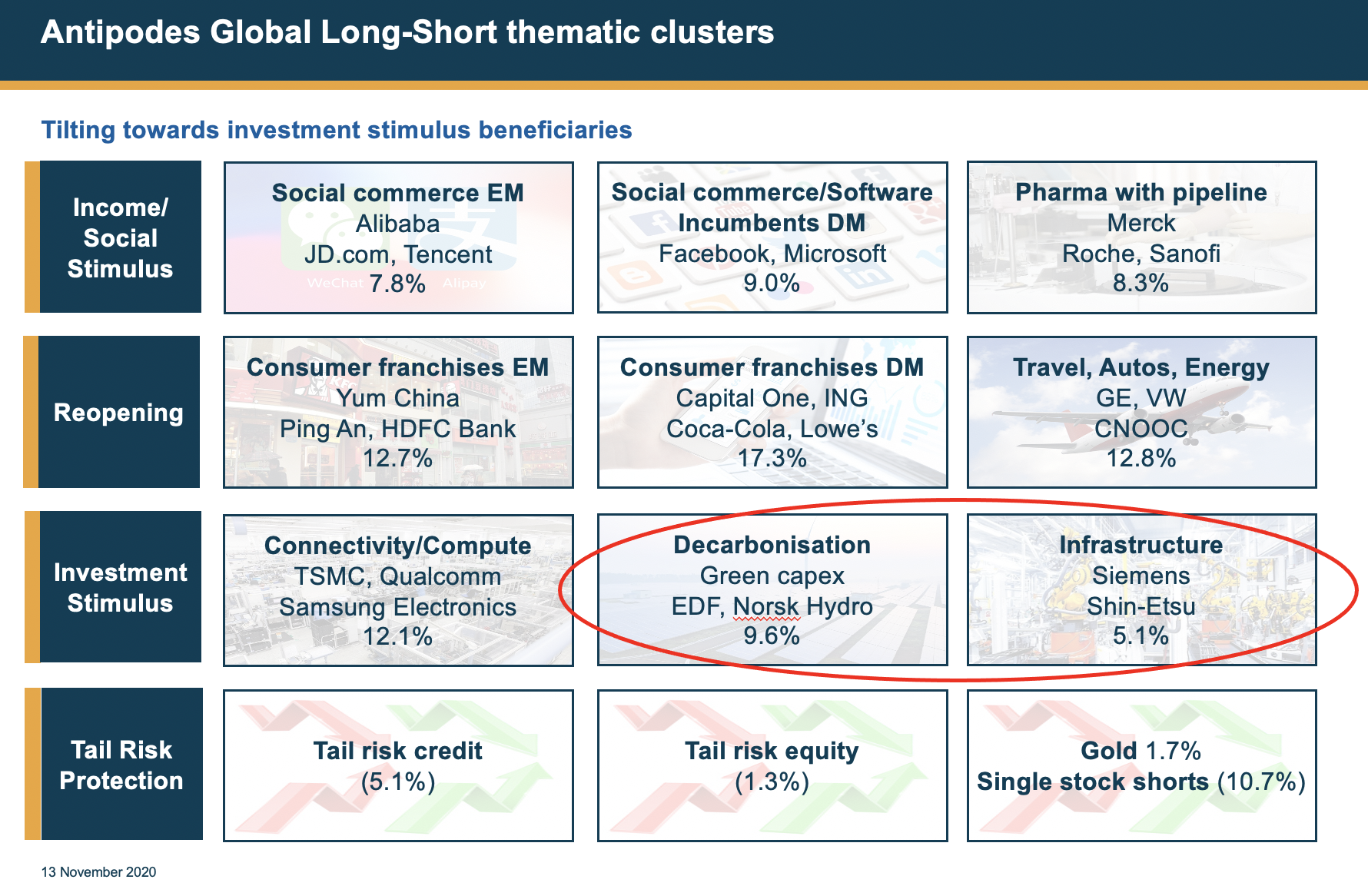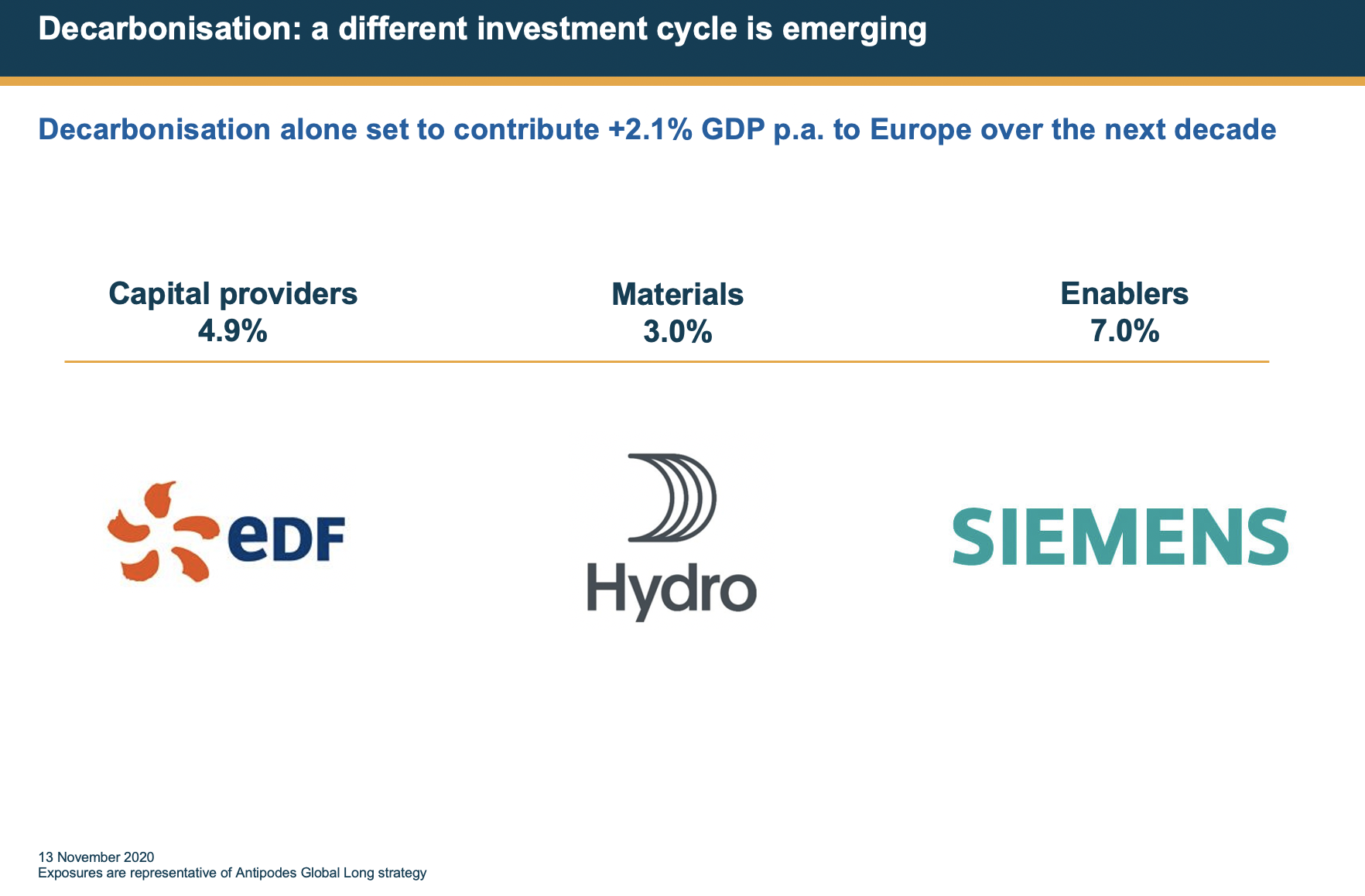Three ways to win with decarbonisation
There’s no denying the world is ‘going greener’. A major structural shift in the way we produce and consume energy is underway and will accelerate significantly during the next decade.
Ignoring this is ignoring a generational investment opportunity.
In the last episode for 2020 on Antipodes’ Good Value podcast, we delve into the political and economic tailwinds supporting the decarbonisation super cycle. These include Europe’s ‘New Green Deal’ which is underwritten by a carbon emissions trading scheme, investment in renewables in the US which could be accelerated under a Democratic Presidency even with a split Congress and China’s push into electric vehicles.
Listen to the episode here or continue reading below, where I highlight three ways to gain exposure to the decarbonisation super-cycle.
Antipodes’ overall global portfolio exposure to beneficiaries of decarbonisation and infrastructure investment has grown to around 15% (as at November 2020).
This exposure is split into three key groups – capital providers, materials companies and enablers - where we think winners will emerge. This provides a robust overall exposure to a key long-term structural trend while achieving a protective form of diversification
Capital providers
Antipodes has around a 5% exposure to ‘capital providers’. These are the power companies that are deploying renewables and will get paid a return for greening the grid.
One the of the key holdings in our portfolio is EDF (Electricity de France) which is Europe’s largest low carbon electricity producer. It owns world scale nuclear, hydropower and renewable assets. We see a huge increase in the demand for electricity under Europe’s ‘New Green Deal’ - whether that’s coming from EVs or reducing fossil fuel-based home heating and power generation.
EDF is also well-advanced in its discussions with the regulator to not only increase the price it receives for regulated nuclear power output which would materially boost returns (the speculation is a 15-20% lift in this regulated price), but also undertake a potentially value-creating company split which could see the company separate its nuclear and renewables business into a separate entity, in which current investors will hold shares. This entity will likely become one of the largest owners and operators of renewable assets in Europe and is materially undervalued within the larger group.
Materials companies
We have around 3% exposure to materials companies. One of our larger holdings is Norsk Hydro, a global aluminium producer.
Aluminium smelting might often be thought of as an old-world industry, but usage is increasingly new world given its light-weighting and recyclable properties. Producing aluminium is incredibly energy intensive, which has typically meant a reliance on cheap coal.
But what we love about Norsk Hydro is that it produces its aluminium from predominantly hydropower, which is sustainable. Norsk’s aluminium has a dramatically lower carbon footprint, it’s approximately 80% lower than the coal-based producers. Demand for lower-carbon aluminium will have a profound effect on the supply side too.
In terms of opportunities on the demand side, autos are a great example. The average car today uses around 180kg of aluminium per vehicle while larger EVs, in a bid to offset battery weight, are increasingly replacing steel with aluminium.
For example, the Tesla Model S and the Audi 8 Tron use 700 – 800kg of aluminium per vehicle. That’s a four-fold increase, which is quite typical for EVs. We think demand from EVs, the light-weighting of SUVs, low-energy buildings and packaging will mean aluminium demand can grow at least 3% p.a. Yet Norsk is valued at a 50% discount to the replacement cost of its unique assets.
There are other interesting materials that we have exposure to in the portfolio, such as nickel and copper, which are also key to decarbonisation and electrification.
Enablers
Around 7% of our portfolio is invested in Decarbonisation ‘enablers’. The Siemens group is a great example.
Siemens parent is a global leader in factory automation, and it’s the only company globally that provides both the hardware to make a plant run as efficiently as possible and also the software, which controls and optimises processes.
As we move into a low carbon world, manufacturers will need to re-tool. On the hardware side this will include robots or energy efficient drives and motors to reduce energy consumption.
On the software side, amongst other things, Siemens’ software allows a company to build a “digital twin” of its product. Rather than having to produce endless prototypes, products can be built and stress-tested in the virtual world. This is incredibly efficient.
Siemens has a Smart Infrastructure division which sells energy efficient building, factory and grid control systems to manage power consumption.
There are also two other subsidiaries which will benefit. There’s Siemens Energy, which supplies the high voltage transmission equipment required to reconfigure the grid and is one of only a handful of companies globally that can produce utility scale gas turbines. The end goal may be zero emissions, but gas is an important ‘transition’ energy as it’s greener than coal and can also help manage peak load. And the other subsidiary is Siemens Gamesa Renewable Energy, which manufactures wind turbines and is a global leader in offshore which is the main growth engine of wind penetration – so a clear facilitator of decarbonisation.
Despite how well-positioned Siemens is, its valued at just 16 times 2022 earnings as cyclical businesses globally have fared poorly this year thanks to COVID and concerns around economic health.
We also have exposure to certain automakers and battery companies.
The market and the media are obsessed with Tesla, but there is another automaker – Volkswagen (VW) – which already produces cars at scale, is on the front foot of electrification, and will likely produce more EVs than Tesla when EV adoption begins to properly ramp up. Only VW is valued at single digit multiples.


Learn more about Antipodes Partners and the firm's approach to investing in global equities.
Visit Antipodes website, or click the 'contact' button below to get in touch.
2 topics
1 contributor mentioned
.jpg)
.jpg)